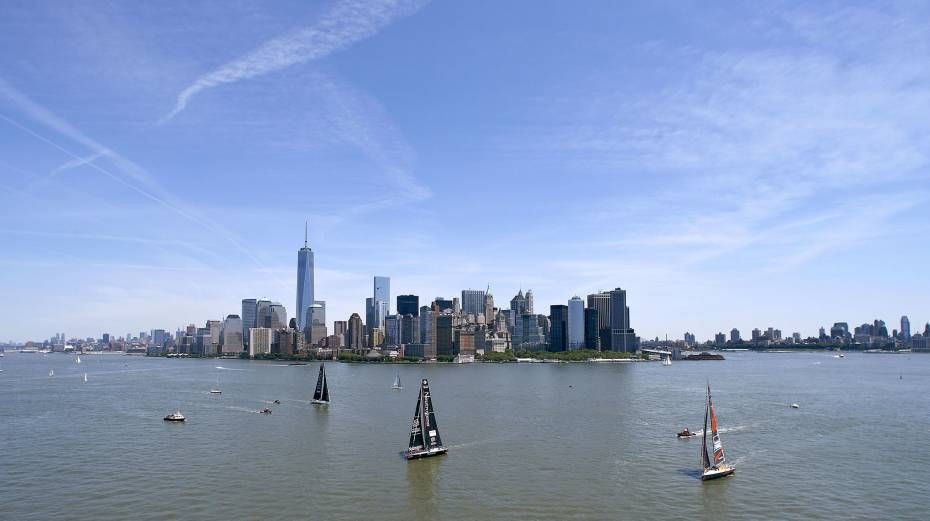New York–Vendée (Les Sables d’Olonne), a breath of fresh air

Less than seven weeks from the start of the New York–Vendée (Les Sables d’Olonne), the solo skippers are working hard with their weather advisors to analyse thoroughly the course and the anticipated weather conditions expected for this unique eastbound transatlantic race. Of course, part of the appeal of this race is the chance to train and qualify for the Vendée Globe while having to go back to basics and shake up the old routines on what, for most, is an unfamiliar course.
Two years ago, the New York – Barcelona race was a prelude to the IMOCA Ocean Masters World Championship and was sailed on a similar course. That race served as a warm-up to the Barcelona World Race running from the foot of Manhattan’s skyscrapers, across the Atlantic and into the Mediterranean concluding in one of Spain’s major ports, the capital of Catalonia. Like the Barcelona World Race, it was sailed doublehanded, enabling the crews to train for their upcoming voyage around the world. In the event, the race proved to have a few surprises in store for competitors, the course revealing itself to be more complex than it had first appeared.
Two sailors who competed in the New York–Barcelona were Spain’s Anna Corbella on GAES Centros Auditivos and Morgan Lagravière who was sailing his first major IMOCA race with Marc Guillemot aboard Safran.
Anna Corbella
Following from her third place in the 2015 Barcelona World Race with co-skipper, Gerard Marin, Anna Corbella has become one of the darlings of Spanish offshore racing. Still hopingto mount an 11th hour campaign for this autumn’s Vendée Globe, she continues to be very active in promoting offshore racing and the IMOCA class in Catalonia.
She recalls the New York to Barcelona Race: “First up we had the start in New York. Setting sail from there, it felt like we were acting in a film - it was incredible. Following that, amid the shipping and in the Gulf Stream, the navigation wasn’t easy, particularly as we were initially punching upwind. Next you have to get used to the new situation: We’re unfamiliar with racing across the Atlantic from west to east. For us, the worst moment involved negotiating a trough where we ended up without any breeze. The rest of the fleet continued to make headway but we were becalmed, even though the GRIB files were showing that there should have been wind. That’s where we lost contact with the leaders.
“Having position reports every quarter of an hour makes for a frantic pace. It quickly becomes exhausting, especially if you’re sailing with the fronts - you find yourself trying to stick with them for as long as possible… That’s etched on my mind because as the first front rolled through, I felt seasick, which wasn’t a great way to start a race.”
Morgan Lagravière
The New York–Vendée (Les Sables d’Olonne) will be Morgan Lagravière’s first singlehanded race aboard his new Safran IMOCA 60. For the young French skipper it will be the culmination of an apprenticeship that began two years ago racing in the New York – Barcelona with Marc Guillemot.
“I obviously remember the start in New York very clearly: It was both magical and complicated, with a combination of wind shifts, current and heavy shipping in the harbour.
“The first few hours of racing required a lot of energy. You had to be constantly on watch for other boats, as well as the numerous navigation marks. After that, there were a lot of serious choices to be made about what course to take and you were torn between the temptation to hunt down the lows to the north and the desire to take the shortest route. What surprised me was that ultimately conditions were a lot more varied than I’d imagined. If the Azores high climbed north, everything could be decided in the last few miles. There wass no single point during the race where you could safely say that victory was in the bag. It was a good test of motivation.”
Teams info
After a stunning 2025 season Sam Goodchild is the IMOCA Globe Series Champion for the second time
After a long season at the top of the IMOCA fleet that featured three race wins, Great Britain’s Sam Goodchild is for the second time in three years the IMOCA Globe Series Champion.
•••Quel rôle peut jouer la course au large dans la transformation du transport international ? Avec Pie…
Pour ce 10ᵉ épisode de Transitions, enregistré au Havre lors du départ de la Transat Café L'Or, nous recevons Jeremy Pochman, PDG de 11th Hour Racing, et Pierre-Antoine Morvan, responsable du pôle course au large et supe…
•••